- I would like to begin by asking you about the Korean term dawon arts that has become a key word on the arts and culture scene in the Republic of Korea in the last few years. The term has become especially well-known since you started using the title “Dawon Arts Festival” for Festival Bo:m. Would you explain to us what dawon arts are?
-
I am often asked by people from other countries what dawon arts means. People from Japan also ask me this quite often. Actually, the fact that we who are involved in contemporary arts here in Korea often debate the definition of the term is evidence that it doesn’t have a fixed definition or concept. I believe we can say that it is crossover art that transcends the conventional boundaries of arts genres to create new art, but there is no set definition in terms of aesthetics or forms. In fact, it is not a category that emerged originally on the arts scene but one that was created for the sake of political convenience.
The late ROK President Roh Moo-Hyun (term: 2003 to 09) had a policy of dismantling the existing hegemony (including regionalism) in South Korean society and politics and distributing authority more evenly throughout the country. That was applied to cultural policy as well. In the Korean arts world, the traditional arts have long had the strongest position in every genre, while alternative arts such as that of interdisciplinary, fringe genre, underground and independent arts tend to be alienated or shut out. In the public-funded support system as well, this trend was very prominent. And, when people tried to get funding for these alternative arts, they were usually hard to categorize because they often spanned multiple genres and couldn’t be classified as theater or dance, or fine art or music. This led to the birth of the term dawon arts.
Since the things that didn’t fit into the conventional genre categories were then grouped together as “dawon arts,” I’m sure it is difficult to grasp what it actually is as a category. I sometimes serve on the selection committees for [arts] grants and there are jury members who have different approaches and values, so it often leads to serious debate over selections. It is quite interesting. - So, in that sense “dawon arts” is actually a category for arts policy, isn’t it?
- It is a category born out of political convenience, but the fact that it lacked a specific definition has led to the emergence of artists who interpret it freely in their creative activities, which in turn has led to a growth in diversity. What’s more, it has brought a new recognition of value in activities and works that were not considered art by the society in general. In Korea’s arts and culture world where things traditional have long held the strongest position, this diversity is a very important thing.
- That fact that the term came first but has led to a lot of new experiments certainly gives us a lot to look forward to from now on. You are at the forefront of that scene with your Festival Bo:m now, but I would like to ask you next about how you became involved in the performing arts world.
- From the age of five I took lessons in traditional Korean dance and at my mother’s recommendation I joined a troupe called The Little Angels. There we studied not only dance but music as well and we went on performance tours to America, Europe and other places around the world. Being involved in the arts like that from childhood, I went to a middle school and high school that specialized in the arts, and for college I went to Ewha Womans University to study in the dance course of its Physical Education Dept. There I majored in modern dance and after graduation I entered the Korean Contemporary Dance Company that only graduates of our course are eligible to enter and was active there as a dancer. So for me, being part of the performing arts world had always been a part of my life and there was no particular event or decision on my part that led to it. It was simply a natural thing for me to be in the performing arts world.
- Having been a dancer like that, what made you change course and become a director?
-
In 1995, I went to New York because I wanted to study contemporary dance there. I studied dance there for about a year, but I was already nearing 30 and I began to question whether or not my future should really be as a dancer and choreographer. Then I became interested in arts management and decided to study English for a year and enter the Arts Management Dept. of New York University.
In America there was of course the language barrier and, being Asian, my position in society as a minority, which led me as an outsider to begin questioning for the first time how I should live my life. Having lived in the Korean social system and confining myself to its dance world with it strongly defined role models, I had never even thought about a way of life for myself outside of that pre-defined world. So, I had just been walking that predetermined path without ever questioning it. But then, looking from the outside at Korea’s performing arts world and my place in it, I realized that what my country needed was not me as a dancer but someone like me who could possibly play a role from a perspective that took in the total picture of the arts, the creative workplace and arts management. - There was the possibility for you to continue dancing in New York or somewhere else overseas.
-
I wanted to get back to Korea quickly. I wanted to take back the things I had learned and put them to use in the field back in Korea.
In fact, while I was in New York, I was participating in the planning stage for the LG Art Center, involving basic plans, programming and marketing projects. And on one of my trips back to Korea during that time I was making preparations to get a PhD in theater studies. That was when I heard that Robert Wilson was going to do a production of The Lady from the Sea at the 2000 Seoul Theater Festival and asked if I could be involved in the project, if only on a volunteer basis. That request got me a position on the planning team with the festival’s artistic director at the time, Shon Jin-Cheak , and that job would become the foundation of my future work in Korea. - What work were you involved in after returning to Korea?
-
I worked as the director for the Modern Dance Festival from 2001 to 2005. Modern Dance Festival has been organized by the Contemporary Dance Association of Korea since 1982, and before I joined, the program had consisted mainly of American contemporary dance or modern dance and the audience was mostly students majoring in dance. Although in name it was an international festival, it was an entirely domestic festival in terms of its system, program and other aspects, and the contents were not up to the international level. My objectives were to work on these basic problems from a professional perspective, expand the spectrum of the program and develop the audience. The present nickname of MODAFE (Modern Dance Festival), it has now grown into one of the ROK’s leading festivals. By the way, I was the one who gave it that name.
Although dance is an art where the body is the expressive medium, today various genre of artistic expression from visual arts and multimedia to video are now approaching and contacting the body. We have brought many works using multiple genres in this way to the Korean audience. We have also begun to expand the audience into the general public, and in one survey by the Ministry of Culture and Tourism we were chosen No. 1 in the category of Korean arts and culture events that foreigners like.
In addition, we have coordinated joint productions between one of the artistically unique artists in Korea’s dance world, Ahn Eun-Mi and his company with Berlin’s House of World Cultures (HWK) to produce the work Let me change your name (05); a collaborative production of Let’s go (05) with Pina Bausch and another production of Rough cut (05) with Pina Bausch and LG Arts Center; as well as creation of the work History of Tears (06) through a collaboration between Seoul Arts Center and Jan Fabre. - Certainly doing collaborative production with such internationally renowned artists must have been quite revolutionary in Korea. After that you started Festival Bo:m. Could you tell us how that came about?
-
After I left the MODAFE office, I wanted to start working with contemporary art on my own. Based on their evaluation of my work at MODAFE, the Ministry of Culture, Sports and Tourism agreed to give me a grant as seed money to organize a “Spring Wave Festival” in 2007.
The curator Kim Song-Won who now serves as the artistic director at the new arts and culture space called Culture Station Seoul 284 that opened this year after major renovations to the old Seoul Station agreed to help me with that 2007 Spring Wave Festival as co-director. Although Kim Song-Won is in a different genre from me, we have similar values and share many of the same interests. Together we selected artists working on the borders of performing arts and visual arts, design and architecture, etc., and we ended up with a festival program of about 15 works, including artists like William Forsythe, Romeo Castellucci and Jerome Bel.
In our efforts to create a new kind of festival that had not existed in Korea until then, we chose these key phrases: “dawom arts,” ““collaborations with young overseas artists,” “building an international network” and “discovering new artists in Korea.” (*) And, with these principles we strove to be a dynamic festival that would function as a hub station in Asian arts and culture. That initial basic vision remains the same today.
Running a festival like this proved to be much more difficult than we imagined and Kim resigned the position of co-director, so I became the sole director and at that time I changed the name to Festival Bo:m. In Korean, the words “spring” and “view” are both pronounced bom. - How do you select the works for the festival’s program? And, do you set a theme each year to focus the selections?
-
Basically, as director I go to see the works performed before making the selection decisions. There may be one or two works in a year that I am not able to go and see, and in that case a decision may be made based on seeing a video of it, but as a rule we always try to see the works in performance before making a decision whenever possible, so I make every effort I can to go and see the works.
In Korea, the post of artistic director has been a sort of honorary position in most cases, with the actual work being done by other people. To do all the curating, programming and the production work and administrative work is a difficult job, but no matter what you call the position, I believe that is the job of an artistic director.
The trunk and roots of a festival is unquestionably the works it presents. In Korea—and I think this is something that can probably be said for Asia as a whole—the arts have long been spoken of and created within the modern Western framework and definitions, and systems have been created within that framework as well. I believe that we still haven’t gotten beyond that point. I look at the art being produced today from an international perspective and choose works that I feel can stimulate the Korean arts scene.
Also, when we go to festivals, etc., around the world we naturally build a network among curators, and that brings in information. There are times when I get information like that and then go to see performances based on that information, and there are times when I go to see the works of artists that I particularly like. Often when I find an artist or a work that looks promising, I do not make a decision to invite them to our festival right away but continue to watch them. I keep contact with the artists and wait for the best time to work with them. I wait for the artists and for the right works. We don’t compromise on quality.
Because I am looking for diversity, we don’t set a single theme for each year’s festival program. This year we present works selected from five viewpoints: “Asian contemporary,” “the map of post-drama theater,” “Japan’s ten generation,” and “the shift of the center from West to non-Western.” At the same time, there are so many things that I learn and feel from each festival that I find the changes that brings to my own way of thinking being reflected in the next year’s works or programming. - How has your programming changed?
-
In the first festival, the aim was to introduce the concept of dawon arts and set the framework for the festival, while in the program of the second festival focused on the shift from Western to non-Western. Then, the third festival introduced new forms of dawon arts in the context of post-drama, non-dance and Performativity. For the fourth festival the scale was expanded and a lineup of world renowned artists in the dawon arts vein were introduced. The fifth festival focused on discovering emerging young Korean artists and concentrating on site-specific works. The sixth festival sought to explore the definition and forms of Asian contemporary and took “Discourse” as the theme of the program. At the end of a festival there will always be things that you regret, and I think that each festival’s program has been the product of those regrets and the desires of the audience that we felt on the scene and the changes that develop in my way of thinking.
I think the biggest change that has occurred in my viewpoint has been the shift from my initial focus on the contemporary scene of Western to a questioning of what is contemporary in the Asian context and what is the potential of Asia. My focus is shifting toward questions of what kinds of artists we have in Asia and how they work, and also seeking out and supporting artists in Korea and in Asia. Recently I changed my direction from one of placing importance on introducing the international contemporary scene in Korea to one of discovering Asian/local artists and supporting their creative activities.
Rather than being a spectacular festival presenting a lineup of the big-name artists, I want our festival to be one that may appear small. - What is the scale of your festival budget?
-
It is such a low-budget festival that I have never wanted to talk bout it with people on the outside. If you heard the actual budget figures you would probably wonder how it is possible to put on a festival of our size with that small a budget. But, I will tell you honestly. We get 150 million won (just over 10 million yen) in funding from the national government. That isn’t much, is it?
Since it is quite impossible to hold a festival on a budget like that, we have formed partnerships with Korea’s National Theater Company, Sogang University Mary Hall, the Arko Arts Theater, the Doosan Arts Center and other theaters and organizations and we make considerable efforts for fundraising. Particularly in the case of theater, even if they want to put on performances of more experimental works, it is difficult for them to do so because they can’t expect to get a sufficient audience. In our festival’s case, we don’t have much in terms of budget but we do have the contents and some amount of audience to offer. So it is a relationship where each side can offer what the other lacks and complement each other. By making active use of this type of partnership, we are able to get the finances we need. - There is surely a need to keep your office operating year-round, and during the festival you have performances going on simultaneously at several venues around Seoul, which requires a considerable amount of staff. Would you tell us what kind of organization you run the festival with?
-
Our permanent staff is three people, including myself. Then six months before the festival we put together a team and hire ten staff members. The small size of our staff is another thing that surprises people.
Our staff doesn’t get paid much but there are always a large number of applicants for the positions. I believe it is due to the programs we have presented up until now, because there are lots of young people who apply saying its because the works are good or because the festival is interesting. Five or six of the part-time staff are repeaters and some of them work at other jobs during the remaining six months of the year so they can continue to work at the festival office. For ticket-taking on performance days and venue set-up and clean-up and such we are joined by student volunteers. I guess they want to be involved because the program is interesting to them. - What is your audience make-up like?
-
At first, when we would have two performances of a work in a 300-seat theater we would only draw an audience of less than 100 and they would mostly be hard-core aficionados of contemporary arts. This year we had a total of 49 performances of 22 works from eight countries and we drew a total audience of 20,000. About 40% of the audience is interested primarily in the visual arts and 20% in the humanities, while the rest are interested in the performing arts or some particular artists. Also, a large percentage of our audience is students, and when they come and see a performance, they will inevitably bring friends along when they come to the next performance. They probably find contemporary relevance in works where expression is done in their own language with a colloquial delivery and treating the issues and problems that they see around them in their own contemporary lives. It makes me very happy to feel that I am with an audience that will be building the future.
Although I am one who studied marketing in the context of a capitalist society, I am now thinking about the possibilities of types of communication with the audience that are different from marketing. One of the important factors in this communication is the contemporary relevance and quality of the works on the festival program. And I am happy to see how communication with a young audience through these works leads to the building of new audience. - Who are some of the artists you are interested in right now?
-
The Thai film director Apichatpong Weerasethakul is one. In 2010, we showed his movie
Uncle Boonmee Who Can Recall His Past Lives
at our festival. He is a director I had been interested in for some time, but when I saw this movie I felt it was dealing with exactly the things I am thinking about now. We in Asia have been influenced by modern Western conventions, thought and ways of thinking, and things like myths and shamanism that lie outside the Western framework tend to be discarded. This movie helped me reflect on how intellectuals can rebel against the domination of Western thought. The version they sent to our festival was the artist’s version, but the Cannes version won the Palme d’Or at the 63rd Cannes Film Festival. I continue to follow his activities with interest.
Among the first generation of Korea’s dawon arts artists I am interested in are Hong Song-Min, So Hyun-Sok, Im Min-woo and Kim Ji-Song. Im Min-woo is an artist who works on a scale that can’t be contained in a gallery, while Suh Yeong-Ran is a dancer who couldn’t graduate because the school said her work wasn’t dance, and if it weren’t for the dawon arts category, her work would probably be treated as non-dance. I want to continue my interest these young artists who straddle the boundaries of conventional genres and be involved as they work to create new possibilities for the future, their own new creative vocabulary, new perspectives and new styles.
Among Japanese artists, I became interested in Toshiki Okada , and in our 2008 festival we had his chelfitsch company perform Hot Pepper, Air Conditioner, and the Farewell Speech . This year we invited Tetsuya Umeda, who has a unique artistic vocabulary.” - I imagine it is difficult to keep finding new artists in the many genres who are not mainstream. How do you build your overseas network?
- I think—and it must probably be the same in Japan—that Asian performing arts professionals like myself had long been looking only at Europe. We never really looked seriously at what kinds of curators, producers and artists there are around Asia. Even though we called ourselves a festival dedicated to contemporary relevance, I had to ask myself if I had really been looking for the contemporary in Asia, and had I really been presenting a balanced program. So, now—although I am not really talking about a strictly Asian community—I am thinking about how to build a network in Asia.
- Finally I would like to ask what you see as the future role of Festival Bo:m.
-
Although this is a bit off the subject, I currently teach at an art university, Kaywon School of Art and Design. I realize sometimes that we now live in times when a person like me who majored in performing arts and visual art can be teaching at an art school. It may just be that the dawon arts concept is not only blurring borders in the arts scene but also the society at large.
Until now I have been involved with a variety of arts genres and the scenes where they are created and I believe that my role and the role of Festival Bo:m to continue to question what contemporary is, without being overly concerned with the concept of dawon arts, and to use the festival to present things that make us feel what is happening in our world today. And, as young people study at school from textbooks based on concepts from the West, I want them to see that that is not the whole picture.
Because the road we have taken is a new one, we have made a number of mistakes along the way. As pioneers of new paths, we are always a minor league, and it is always a struggle. What I want is to continue to lay a role in the Korean arts world and in society that only I and Festival Bo:m can play.
Kim Seong-Hee
Pursuing the possibilities of multi-genre “dawon arts”
Festival Bo:m
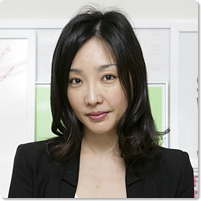
Kim Seong-Hee
Kim is the director of Festival Bo:m, an associate professor at Kaywon School of Art & Design, artistic director of GANESA PRODUCTION and co-publisher of the dawon arts publication Ob_scene . She also serves as a committee member of Gwangju Asia Cultural Development Institute, the Korea Society of Documentation and a member of the board of directors of the Korea Arts Management Service.
After graduating from the dance course of Ewha Womans University, Kim received a Master’s Degree in arts management from New York University and a doctorate in business management from Kyung Hee University. She was active as director of the MODAFE festival from 2002 to 2005 and in 2007 she started the Spring Wave Festival. From 2008 the festival name was changed to Festival Bo:m and she continues to serve as its director.
Kim coauthored the book Arts Management (2002) and Theory and Practice in Arts and Culture Management (2002) and in 2012 will publish Future Arts .
Interviewer: Kyoko Kimura (Seoul-based performing arts coordinator, translator)
Photos courtesy of Festival Bo:m
(*) Festival Bo:m’s key phrases:
The Festival Bo:m is an international festival of performing arts and visual arts that is multi-cultural as well as multi-genre.
The Festival Bo:m produces art works and productions by Korean as well as international artists whose works represent an unique vision in their art.
The Festival Bo:m will introduce innovative and avant-garde Korean and international art works.
The Festival Bo:m values the spirit of experimentation and challenge, and places the focus on discovering new artists which are at the heart of the festival.
The Festival Bo:m strives to introduce artists with diverse cultural background especially from Asia on the international stage.
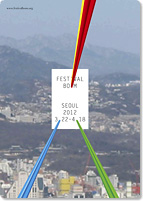
Festival Bo:m
Address:
Angel Bldg. 6F 12-2 Gwancheol-dong, Jongno-gu, Seoul, Korea
festivalbom[a]gmail.com
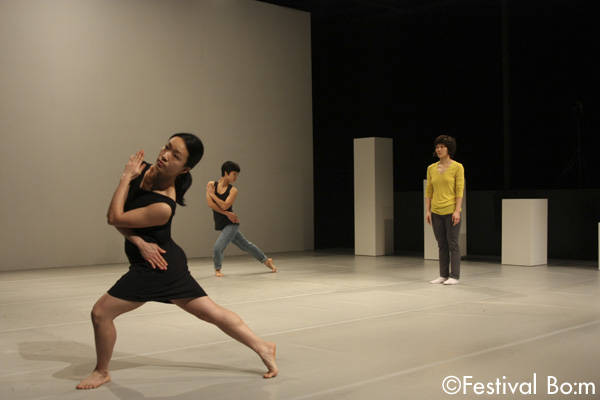
Nam Hwa-Yeon
A Garden in Italyy
(2012)
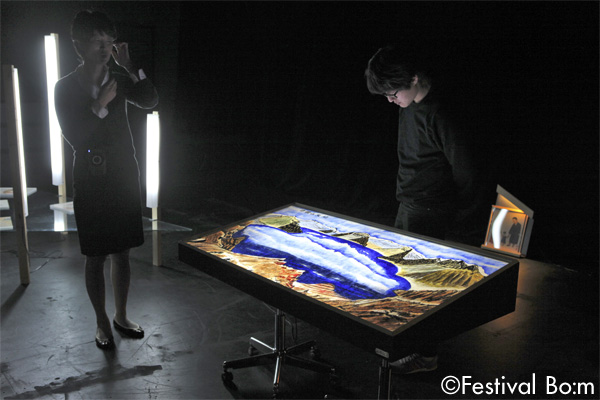
Hyum See-won
Cheonsoo Mart 2nd Floor
(2012)
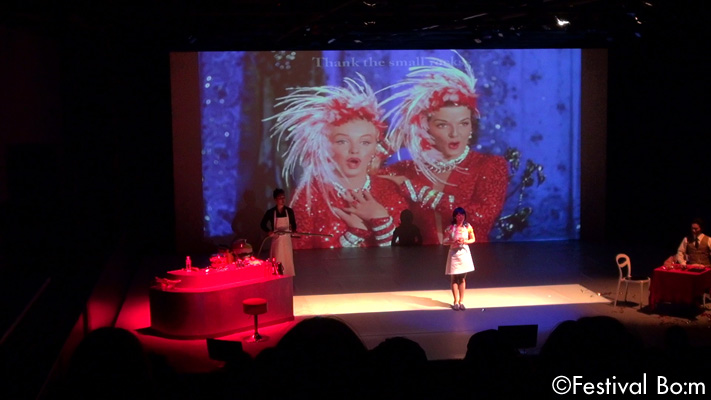
Hong Sung-min
The Movie
(2012)

Chang Hyun-joon
The Occurrence of a Theater
(2012)
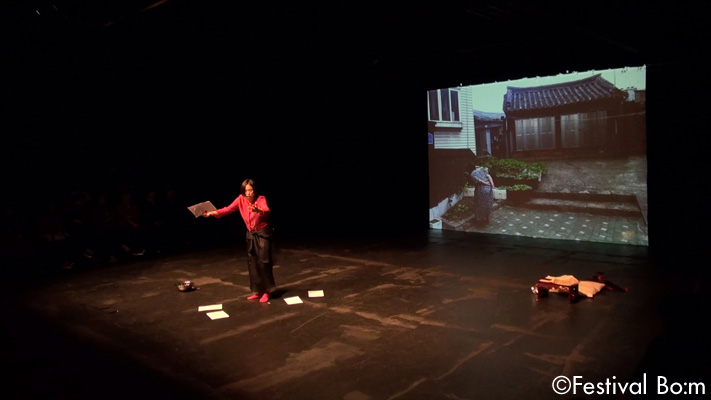
Suh Yeong-Ran
I Confess My Faith
(2012)
Related Tags

